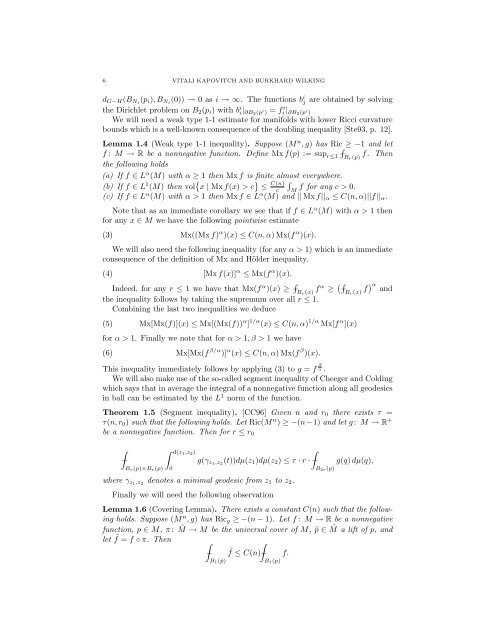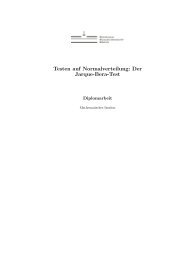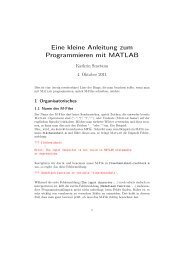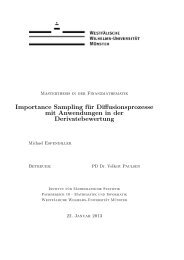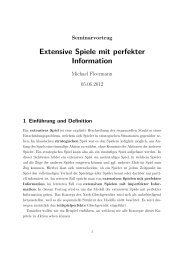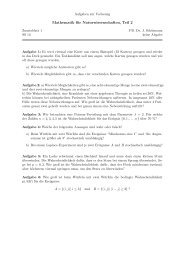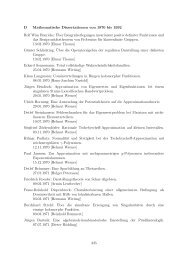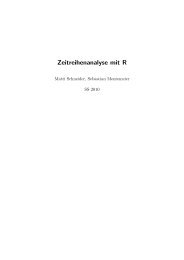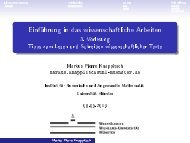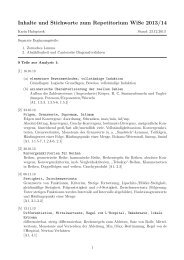Margulis Lemma
Margulis Lemma
Margulis Lemma
You also want an ePaper? Increase the reach of your titles
YUMPU automatically turns print PDFs into web optimized ePapers that Google loves.
6 VITALI KAPOVITCH AND BURKHARD WILKING<br />
d G−H (B Ni (p i ), B Ni (0)) → 0 as i → ∞. The functions b i j are obtained by solving<br />
the Dirichlet problem on B 2 (p i ) with b i i | ∂B 2(p i ) = fi i| ∂B 2(p i )<br />
We will need a weak type 1-1 estimate for manifolds with lower Ricci curvature<br />
bounds which is a well-known consequence of the doubling inequality [Ste93, p. 12].<br />
<strong>Lemma</strong> 1.4 (Weak type 1-1 inequality). Suppose (M n , g) has Ric ≥ −1 and let<br />
f : M → R be a nonnegative function. Define Mx f(p) := sup r≤1 − ∫ B r(p)<br />
f. Then<br />
the following holds<br />
(a) If f ∈ L α (M) with α ≥ 1 then Mx f is finite almost everywhere.<br />
(b) If f ∈ L 1 (M) then vol { x | Mx f(x) > c } ≤ C(n) ∫<br />
c<br />
f for any c > 0.<br />
M<br />
(c) If f ∈ L α (M) with α > 1 then Mx f ∈ L α (M) and || Mx f|| α ≤ C(n, α)||f|| α .<br />
Note that as an immediate corollary we see that if f ∈ L α (M) with α > 1 then<br />
for any x ∈ M we have the following pointwise estimate<br />
(3) Mx((Mx f) α )(x) ≤ C(n, α) Mx(f α )(x).<br />
We will also need the following inequality (for any α > 1) which is an immediate<br />
consequence of the definition of Mx and Hölder inequality.<br />
(4) [Mx f(x)] α ≤ Mx(f α )(x).<br />
Indeed, for any r ≤ 1 we have that Mx(f α )(x) ≥ − ∫ B r(x) f α ≥ ( − ∫ B r(x) f) α<br />
and<br />
the inequality follows by taking the supremum over all r ≤ 1.<br />
Combining the last two inequalities we deduce<br />
(5) Mx[Mx(f)](x) ≤ Mx[(Mx(f)) α ] 1/α (x) ≤ C(n, α) 1/α Mx[f α ](x)<br />
for α > 1. Finally we note that for α > 1, β > 1 we have<br />
(6) Mx[Mx(f β/α )] α (x) ≤ C(n, α) Mx(f β )(x).<br />
This inequality immediately follows by applying (3) to g = f β α .<br />
We will also make use of the so-called segment inequality of Cheeger and Colding<br />
which says that in average the integral of a nonnegative function along all geodesics<br />
in ball can be estimated by the L 1 norm of the function.<br />
Theorem 1.5 (Segment inequality). [CC96] Given n and r 0 there exists τ =<br />
τ(n, r 0 ) such that the following holds. Let Ric(M n ) ≥ −(n−1) and let g : M → R +<br />
be a nonnegative function. Then for r ≤ r 0<br />
∫<br />
−<br />
B r(p)×B r(p)<br />
∫ d(z1,z 2)<br />
0<br />
∫<br />
g(γ z1,z 2<br />
(t))dµ(z 1 )dµ(z 2 ) ≤ τ · r · − g(q) dµ(q),<br />
B 2r(p)<br />
where γ z1,z 2<br />
denotes a minimal geodesic from z 1 to z 2 .<br />
Finally we will need the following observation<br />
<strong>Lemma</strong> 1.6 (Covering <strong>Lemma</strong>). There exists a constant C(n) such that the following<br />
holds. Suppose (M n , g) has Ric g ≥ −(n − 1). Let f : M → R be a nonnegative<br />
function, p ∈ M, π : ˜M → M be the universal cover of M, ˜p ∈ ˜M a lift of p, and<br />
let ˜f = f ◦ π. Then ∫<br />
∫<br />
− ˜f ≤ C(n)− f.<br />
B 1(˜p)<br />
B 1(p)


